#the feast of fools
Text
HAPPY TOPSY TURVY DAY!!!
Tagging my very few Hunchback moots 😂: @i-am-befuddled @lisimcpisi @theoptimistictabby @real-artemis @satanic-witchcraft
#the hunchback of notre dame#topsy turvy#topsy turvy day#feast of fools#the feast of fools#festival of fools#the hunchback of notre dame musical#hunchback musical#quasimodo#dom claude frollo#claude frollo#judge frollo#jehan frollo#captain phoebus#phoebus de châteaupers#esmerelda
27 notes
·
View notes
Text

The Feast of Fools
33 notes
·
View notes
Text
ʎɐp ʎʌɹn┴ ʎsdo┴ ʎddɐH
11 notes
·
View notes
Text
The ringer of the bells 🔔 , that hump upon his back.
That face right ✅️ out of hell, Quasimodo we like 👍 .
It's Esmeralda's name that makes his poor 😔 heart 🥰 tick.
He's twisted deaf and lame that's who we'll have to pick
1 note
·
View note
Text


Shiny new commission sheet! 👌🏼✨
Notes: I have the right to refuse any commission should they go against my rules!
Payment upfront before beginning rough draft!
I am also a full time student so my priorities are split! But I will do my best to keep you updated on your piece! Thank you! 💕
Edit: New terms, price adjustments and new fandoms offered! Edited by @damnilovefaerghus !
#come one come all!#join the Feast of Fools!#jk jk#I’m apologize if I’m still remaining with just 3H characters#it’s all I can really focus on atm#but I hope some time in the future I can add other fandoms and OCs!#but for now this will have to do!#:: koko speaking!#commissions
191 notes
·
View notes
Text
Feast Mode: Activated.
Have you ever wondered what the animals like to eat at the Aquarium? From sea turtles munching on lettuce to anemones gulping down a delicious gooey krill shake, our diverse collection eats a variety of foods throughout the day. In the Kelp Forest exhibit, our dazzling divers deliver baitfish, squid, and shrimp to keep our residents healthy!

#monterey bay aquarium#lettuce feast#dindin for our finfins#excuse me are you going to finish that#dont let the image fool you those fish are very impolitely waiting their turn
996 notes
·
View notes
Text
I think we (Queer Christians) should bring back the Feast of Fools! Here's my pitch:
Medieval Christians celebrated the days following Christmas with societal inversion. If God became a vulnerable child born into poverty, then the best celebration should invert the social order: master and servant, clergy and laity, man and woman. The Feast of Fools–held on January 1st–was the most notable celebration of cosmic inversion. Developed in the late 12th and early 13th centuries, the tradition of the feasts continued until the 16th century. (1)
The festival is popularly misunderstood as a celebration of sacrilege, a result of its apparent burlesque of religion. Yet, the festival’s role reversals were prescribed by clergy, and the "fools" represented those chosen by God for their lowly status. From surviving 13th century manuscripts–notably, the Play of Daniel from Beauvais Cathedral and the Office of Joseph from Laon Cathedral–it is clear that some Catholic Churches in France sanctioned cross-dressing for liturgical purposes. (2) In fact, the Feast of Fools is remarkable for being sanctified rather than sacrilegious.
Many anthropologists of religion have argued that “sacred play,” or “ludic ritual,” is central to how religious behaviors function. (3) Although play may seem counterintuitive to religion, absurdity and holiness often go together, especially considering the role reversals and revelry of the Feast of Fools.
Literary critic Mikhail Bakhtin made a similar argument about the “carnivalesque.” (4) When absurdity is celebrated in religion–when a society’s usual rules are suspended–observant revelers can stretch the boundaries of their identities or reverse their social roles. Men become women; laity become clergy; God becomes a helpless infant; death becomes life. It is on the strength of the absurd that religions delve into hope and new ways of becoming. (5) “Sacred play” is reality altering work, a cornerstone of religious enlightenment and religious embodiment.
In 1969, theologian Harvey Cox proposed that an imitation of the medieval Feast of Fools could rejuvenate modern Christian spirituality, lamenting that the tradition has forgotten sacred play. (6)
As found in the Medieval Feast of Fools, the joy of inversion and freedom of death were, at one point, celebrated in Christian tradition through cross-dressing. Drag exists in Christian tradition as an artform that is capable of embodying the Divine. Sharing in Christ’s martyrdom is only part of Christian embodiment, and redemption and resurrection are essential to any imitation of Christ. Through embodying Christ, religious drag can become a project of resurrection.
(Taken from my Master's Thesis in Art History, "Crucifixion Can Happen To Anyone: Embodying Christ Through The Queer Artist")
1: “Feast of Fools.” n.d. Encyclopædia Britannica.
2: Harris, Max. 2011. Sacred Folly: A New History of the Feast of Fools. Cornell University Press. 113-127.
3: Turner, Victor. “Liminal to Liminoid, in Play, Flow, and Ritual: An Essay in Comparative Symbology.” Revista Mediações, vol. 17, no. 2 (2012): 214–57.
4: “Carnivalesque.” n.d. Oxford Reference. Accessed 12 July 2023.
5: Kierkegaard, Søren. “Fear and Trembling.” From Selections from the Writings of Kierkegaard. University of Texas, Austin, Texas, 1912.
6: Cox, Harvey. 1969. The Feast of Fools; a Theological Essay on Festivity and Fantasy. Harvard University Press
47 notes
·
View notes
Text
Marchil crumbs part 5
Part 1 - Part 2 - part 3 - part 4 - part 6 - part 7
The anime has come and since I have my shipping goggles on I am going to notice so much. This part will be less spoilery for anime onlys (tho if you want to see me talk about why I ship them and why they’re complementary this is not a good part to start with haha). Edit: After completing this part I can confirm it’s fully anime-onlys friendly and spoiler-free! For manga veterans though there are still some fun tidbits to be found, some recontextualisations and new extra content.
Holy shit guys they’re mirroring each other in the mural and reaching out to each other AND looking towards each other?!!!! Their pose is so striking and like perfectly align?! Which means it was so intentional and the staff wanted to highlight them (for an aesthetic and/or narrative purpose I’m sure but it happened)! I will never let this go we won so fucking hard let’s goooooo we are so back
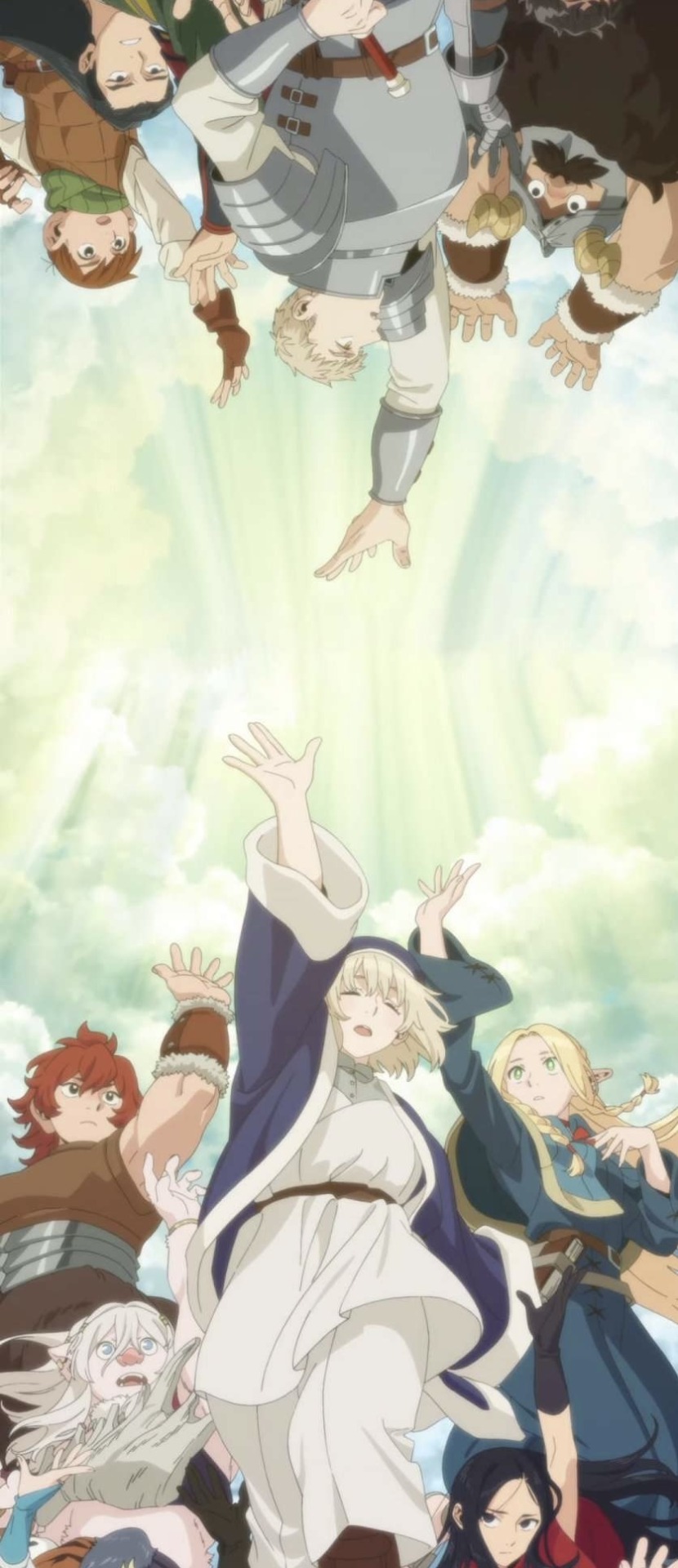
Character foils!! Dynamic duo!!
Soulmates!!
In the opening at 1:16 he looks at her to see if she’s really going to it as the most critical of monster food & muster up courage to dig into it himself lmao… "Marcille doesn’t look too grossed out, she’s picky so this food must be fine then" Aka treating her as a poison taster/good cuisine judge lmao
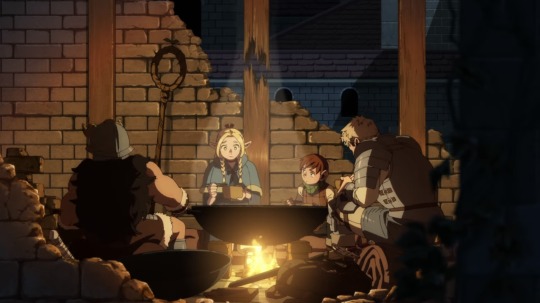

Doodle from the animation director (source). I should translate it but I’m procrastinating on it so uh director’s brotp? Anyways they hanging out look at them :]
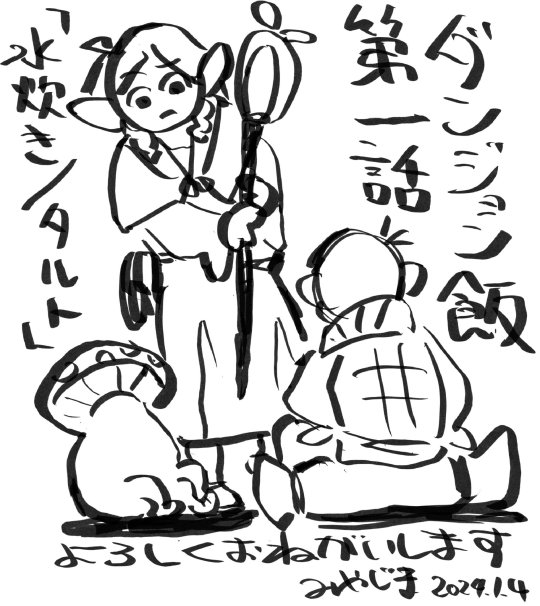
Laios is thinking to himself there (he’s the one saying the subs), and in the meantime Marcille and Chilchuck talk, likely figuring out the money situation. Strategizing duo back at it again not wasting a second

In the beginning of ep 1, when Marcille is rambling about where they could go to get food and what to grab, Chilchuck listens with a big smile & even closes his eyes as they walk. The implication is that he’s thinking about food, but man the scene hits different now that it’s voiced and I remember that indeed Chilchuck is closing his eyes to her voice and enjoying hearing her talk and ramble. I may be too far gone into the marchil pit
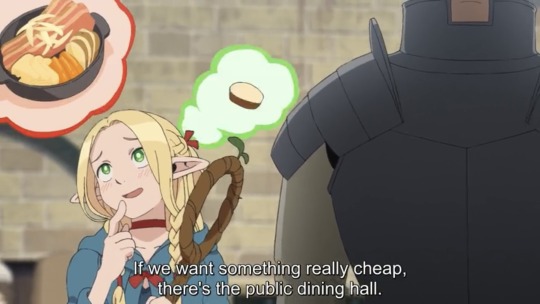
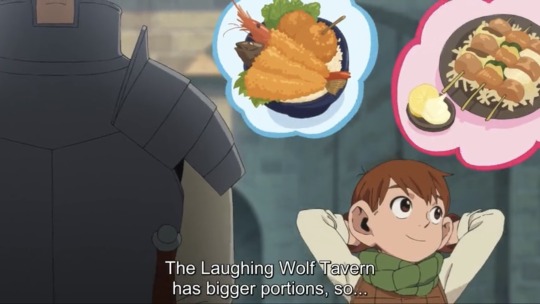
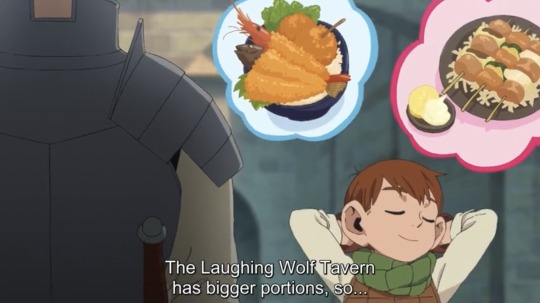
I feel like already they’ve come far from when Chilchuck dreaded being alone with Shuro and Marcille, waiting for the Toudens and Namari to arrive.
Ok this might actually be smth I’m gonna complain about but I feel like blushes have been drawn too vividly so far. Why does Chilchuck look like he’s confessing when he tells her she’s not a burden and he didn’t mean to make her feel that way. It almost comes across as "Woah she cares what I think?" 💀 The banter ensuing is of course also great


Ep 2 was an episode centered on them both that had the "Magic/Traps are my domain, don’t interfere!" parallel…
And now with ep 3 we’re back to them being haters together. That’s her emotional support man

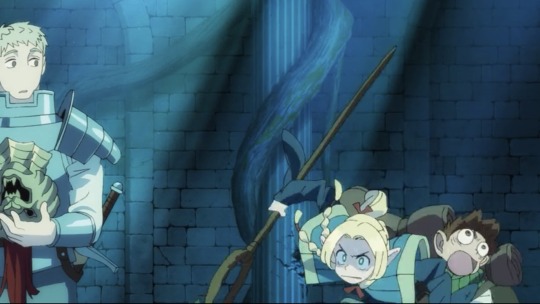
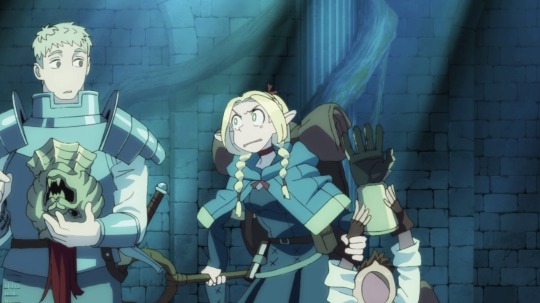
In ep 4, it doesn’t show well with a screenshot but when Senshi talks about his unmanned vegetable stand with a treasure chest, while in the manga Marcille and Chilchuck both think the same thing, "That’s why that treasure chest akways had money in it…", but in the anime instead they literally finish each other’s thought. Talk about being on the same wavelength.
Ep 5 is a marchil goldmine actually, it showcases perfectly how much of a package deal they are lol. Always sticking close to each other. Glancing at each other during meals… They literally nod at each other before they try a bite to steel themselves. They exchange a serious thoughtful glance when Laios talks about Falin truly being gone atm. They argue a bit but they go right back to sitting right next to each other after the meal <3 My god I can’t deal with them they are so…… "Hate this bitch, not my friend" 3 secs later "Heyy bestie!!" Also he’s worried he brought her mood down after mentioning Falin. Made a post about ep 5 collecting even more screenshots.

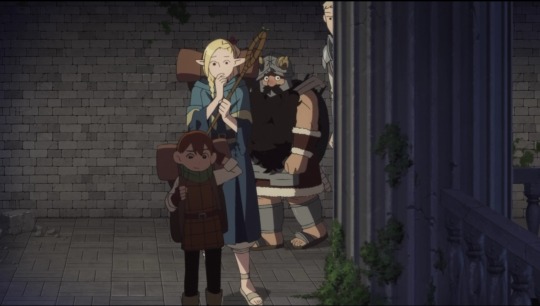

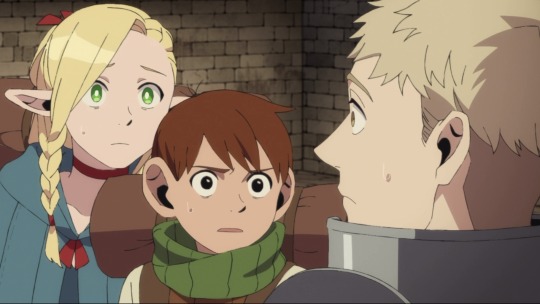

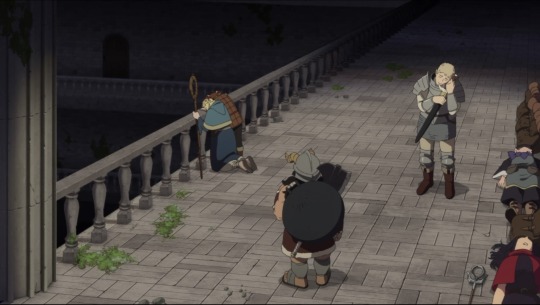
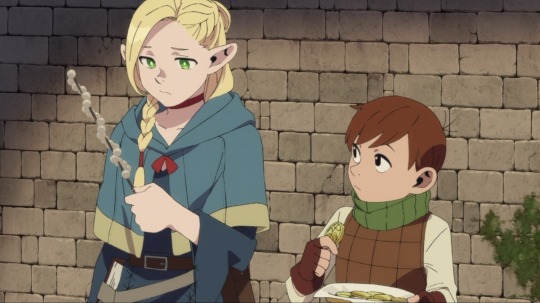
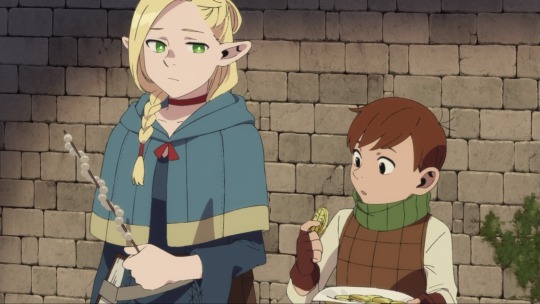
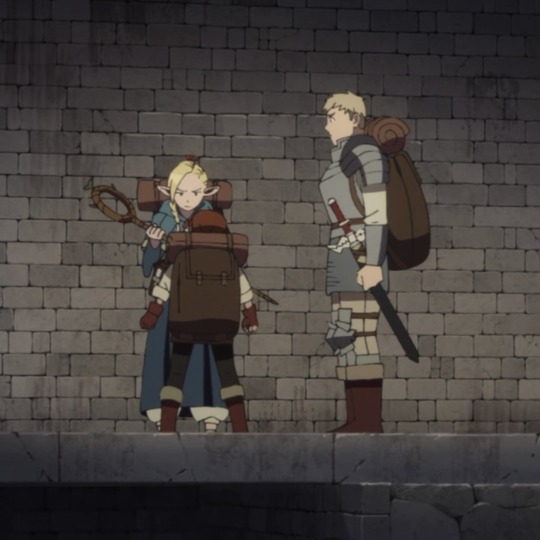
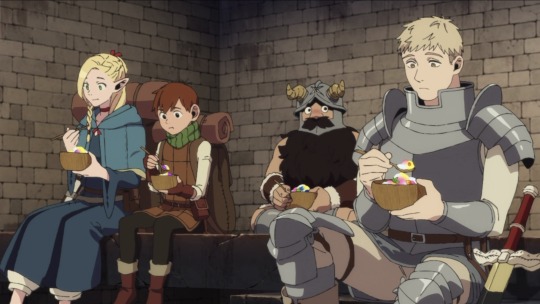
Episode 6 my hero my beloved… Again I made a post about the ep collecting all my screenshots here, and even a clip! But this IS the marchil crumbs masterpost thus I must collect the major ones here as well. First of all, fun staff drawings for the first screening!

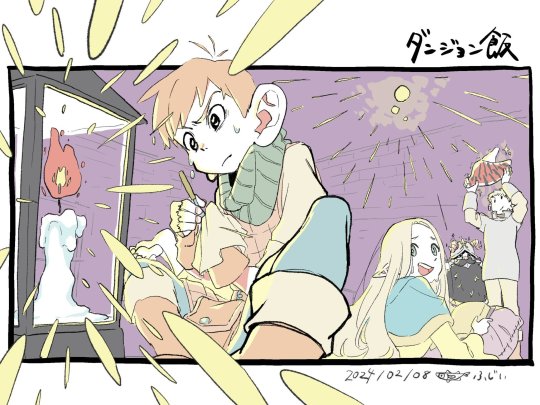
I already posted a screenshot from the trailer of when Chil had his head on his knees sitting next to her, but after seeing episode 5 I think it’s a fun and interesting trend to notice that they sit next to each other way unnecessarily close wow.
They continue to banter a ton, she continues to be very casual with touch, and they’re really cute! I love just how much Marcille blushed damn- It’s really cute too when you remember with the bicorn chapter that Chilchuck teases Marcille BECAUSE he enjoys getting a rise out of her, flustering her and seeing her reactions. I support the teasing -> laughing because her reaction is over the top all-Chilchuck economy. Also she apologizes for having let him go alone and be gone for so long by helping him with sewing his cowl… Cuties

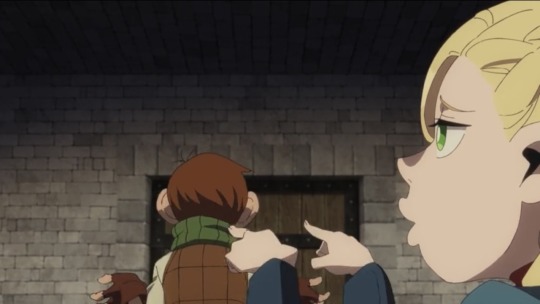
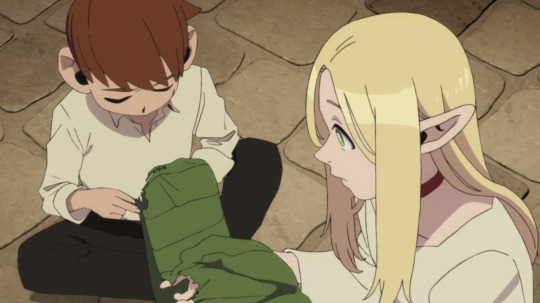

She looked so happy when he opened up about his age!… And then seemed… Disappointed? When he "truly was just a kid". "So you really are a kid! How boring…" This implies that her intent was to tease him for funsies…
Ok lads we reached 30 pics see you next post, I’m gonna cover the "wake up clumsy head" manga-anime differences and we’re gonna go back to our usual spoilers yummy schedule.
Here’s Marcille cosplaying as a succubus in the newest Daydream Hour… She may not be a half-foot or have deep-set eyes but let’s be real I think he’d explode
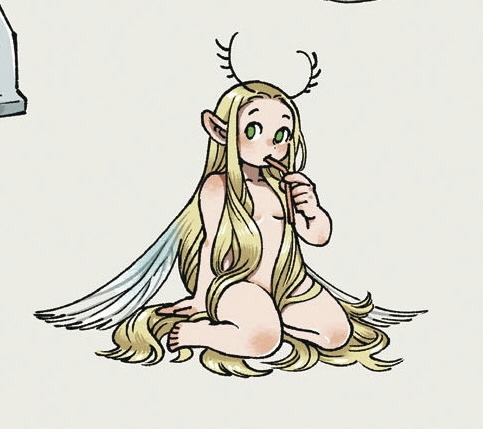
part 6 here!!
#Dungeon meshi#dungeon meshi anime#marchil#Chilchuck tims#marcille donato#ppl in the server don’t agree with me that the mural mirroring is huge… I am alone on this barren earth#/lh#This is one day after I said I had no more marchil crumbs. Yesterday me was a blind fool#This part is only halfway done I’ll edit in more stuff as we go and I find more crumbs#Bros… Broskis I’m losing my mind#The mural……..#Idk if I wanna go there but this might be my favorite/the biggest marchil crumb. Holy shitttttt#For legal reasons /j disclaimer that yes yes I’m sure the staff’s intent wasn’t shippy like I said#But also I think it kinda undeniably ties them together in some way. Shows a bond either from a meta a narrative or an interpersonal#Standpoint. Their pose align and mirror perfectly but beyond them and Laios & Falin that can’t truly be said with anyone else. WHAT DOES IT#MEAAAN. It’s probably just bc it’s a nice composition 😔 But it happened and that means marchil nation is feasting today#Anyways I like my ship crumbs post to flow nicely from one point to another like a web but for this one i’mma be putting them in the order#That they come at since I don’t have them all on hand from the start
35 notes
·
View notes
Text
Best character surnamed: Xiang
Come and vote for the best characters with the same surname!*
What does best mean? It's up to you! Whether you love them, are intrigued by their characters, love to hate them, or they're your '2 second blorbos whose personality you made up wholesale', these are all reasons for you to vote for your favs!
*note, the surnames are not exactly the same in all the cases, as often there will be a different character. I am, however, grouping them all together otherwise things got more complicated.
Propaganda is very welcome! If I’ve forgotten anyone, let me know in the notes.
This is part of a larger series of ‘best character with X surname’ polls’. The overview with ongoing polls, winners, and future polls can be found here
#poll#lost you forever#after playing the fool and marrying the blind villain#the bond#royal feast#the myth
21 notes
·
View notes
Text

Umm whats the meaning of this shit?? I feel like John Mulaney saying “and also with you” except it’s “faith, divine nature, individual worth, knowledge, choice and accountability, good works and integrity, and virtue” (the last of which was tacked on in my time bc we were all such sluts I guess)
I mean divine nature is still there but it’s pretty cool that today’s young women get to be faithless, individually worthless, ignorant, powerless and unaccountable, unproductive and dishonest and sexually active
(Actually except for the last one I don’t think that’s far off)
#‘qualify for exaltation’ is pretty gross though#might i recommend brandi carlile’s sinners saints and fools#exmormon#exmo#apostake#apostate#feast and testimony
15 notes
·
View notes
Text

Would anyone like to taste some raw "ground beef" treats? No human meat was involved in making these. Promise~ 😉
(These meaty looking Rice Krispies Treats were made with Rice Krispies cereal, marshmallows, butter, red food coloring, dark cocoa powder, and vanilla extract.)
#the texas chainsaw massacre#leatherface#bubba sawyer#food#dessert#hzz photography#hzz feast#april fools day#texas chainsaw massacre
64 notes
·
View notes
Text
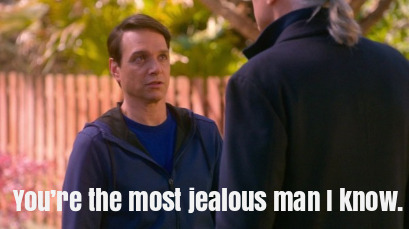


Stop proving him right, Terry!
#i made this in 5 minutes#silverusso#daniel larusso#terry silver#cobra kai#in which i post my nonsense#sweep the leg#in the courtyard of fools we feast
112 notes
·
View notes
Text
The feast of fools, the feast of fools.
1 note
·
View note
Text
Minor detail but I've noticed not a single Hunchback of Notre Dame adaptation I've seen seems to remember the story starts in January.
#feast of fools#it never looks much like winter in any of them. 1956 for all it's adherence to the text looks downright summery#you can't tell in 1939 but they filmed that in the desert and apparently it was hot as af#1977 maybe it's hard to tell#nitpicking lmao#notre dame de paris#the hunchback of notre dame
8 notes
·
View notes
Note
OOH girl I was just thinking about Enji in a “fucking shotos friend” kind of way! It’s giving all the dilf energy, and is of course an after UA affair 😌😮💨
No but please I'm 🥴 thinking about that!
Shoto knew you and Enji had met once when you had come to his house to drop something off when he was still living in his Father's house before he got his place, but never in his wildest imagination did he think that he would ever come back to his childhood home, on request of Hawks because Enji had called in to work and wasn't picking up his phone, and find him rearranging your guts on the living room couch.
He wouldn't know what to do and would probably just walk out. and never able to look his dad in the eye ever again.
#GOD NOW IM THINKING ABOUT THIS#my brain is smush thinking about this awkward dynamic i love it so much#Please if you have more thoughts on this COME BACK AND SCREAM AT ME ABOUT IT IM FEASTING#the relationship between shoto and enji would be so TENSE because in my head shoto has been in love with you for a long time#so this is AWKWARD because you and enji have actually secretly started dating and fooling around out of public eye#so hes really the first to find out about you two#AWKWARD ITS ALL SO CRINGE IM SCREAMING I LOVE THIS OKAY????#enji todoroki x reader#shoto todoroki x reader#inbox 💌#em writes ✍#em talks 👄
32 notes
·
View notes
Text
A Medieval Christmas
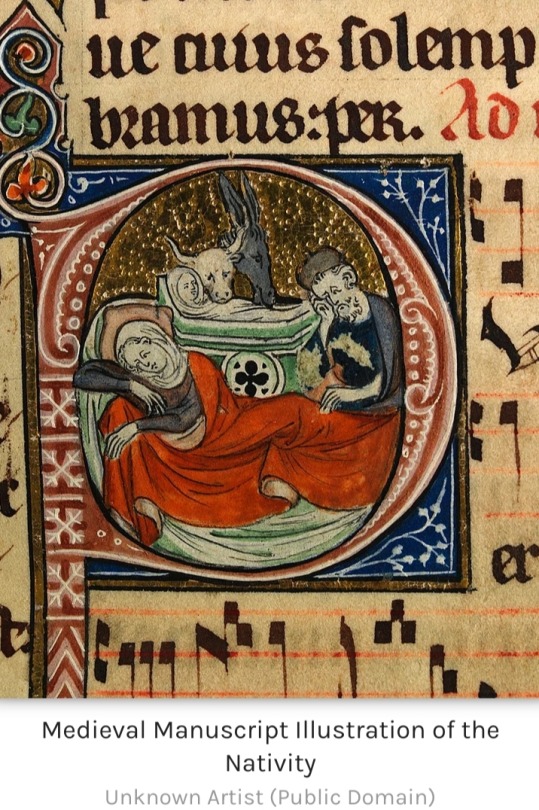
By Mark Cartwright
1 December 2018
Christmas was one of the highlights of the medieval calendar not only for the rich but also for the peasantry.
For the longest holiday of the year, typically the full twelve days of Christmas, people stopped work, homes were decorated and a Yule log burned in the hearth.
Gifts were exchanged, colourful church services enjoyed, and merry feasts were eaten by all where there was better food and more of it than at any other time in the year.
There were plenty of songs, dancing, pantomimes, and games, too. For many, just as today, Christmas was the best of times.
The European medieval calendar was not short of holidays: each season had its own special Christian celebration, often based on older pagan traditions.
Medieval holidays were a chance to have a much-needed rest from the usual daily toil and to socialise at family meals where the typical dreary menu of the poor was replaced by such rarities as meat and fish, and the table of the rich was adorned with exotica like roast peacock.
Christmas was the longest holiday of the year by far and lasted from the night of Christmas Eve, the 24th of December, to the Twelfth Day, Epiphany, on the 6th of January.
Mid-winter was a time of year, which saw a lull in agricultural activity, and consequently, many peasants were permitted by their lord to have the entire two weeks off.
The season also involved gift-giving and decorating the home with garlands and wreaths of winter foliage.
As one description of 12th-century CE London by William Fitzstephen records:
"Every man's house, as also their parish churches, was decked with holly, ivy, bay and whatsoever the season of the year afforded to be green."
(quoted in Gies, 100)
Holly, with its glossy dark green leaves and bright red berries, has been considered the ideal winter decoration since antiquity.
Ancient Celtic druids thought it sacred and able to ward off evil spirits, while the Romans used it as a gift to show esteem and goodwill.
Mistletoe is another long-used decoration, which ancient people thought a bringer of fertility, protector of crops, and something that kept away witches.
Long before the Christmas tree took centre stage in the 19th century CE, a double ring of mistletoe was the centrepiece of many a home's decorations, under which couples could kiss, removing the jewel-like berries with each peck.
Over time, the traditional church services for major Christian holidays became more elaborate and Christmas was no exception.
The Church at Christmas

Naturally, in the very religious communities of medieval times, the local church was a focal point for the Christmas celebrations and services were well-attended by all classes.
One development from around the 9th century CE was 'troping,' which was to add extra dialogues and songs to the service.
An example of troping in the Christmas celebration was an elaboration on the question, which choirs sang:
Quem quaertitis in praesepe? ('Whom do you seek in the manger?').
One half of the choir would sing the line and then the other half did.
This eventually led to a dramatisation using individual speakers and actors, which resulted in the presentation of nativity plays with the Magi and King Herod playing prominent roles.
Another play that became popular in church services of the festive period was The Prophets in which a priest conducted a dialogue with various prophets such as Jeremiah, Daniel, and Moses.
Choir boys played dressed up bit-parts like a donkey or devil.
The Feast of the Holy Innocents (Childermas) on 28th of December commemorated King Herod's failed attempt to murder the infant Jesus by ordering the execution of all children in Bethlehem under two years of age.
The church on this day, perhaps bizarrely considering the gravity of the occasion, indulged in a bit of traditional festive role-reversal with choirboys taking the place of the bishop and other higher clergy to conduct services and even to lead a torchlit procession.
The celebration of the Feast of the Circumcision, held on the 1st of January, was even more outlandish, which perhaps explains its other name of the 'Feast of Fools.'
Minor clergy would wear their clothes inside out and lead an ass into church where, upon arrival at the altar, they would burn incense made from old shoes, eat sausages, drink wine and make the sounds of a donkey.
The local clergy, if not invited to their nearest lord's castle, celebrated with a fine meal of rarities at home.
Larks, ducks, and salmon could appear on the menu, or perhaps a kid. We know one abbot of Ramsey Abbey in England reserved for himself a wild boar each Christmas dinner.
Even monks had a treat or two at Christmas. The diet of those in medieval monasteries was quite good anyway but Christmas feasts included more meat and fish than usual.
We also know that at monasteries such as at Cluny Abbey in France, the monks received a new gown and had one of their twice-yearly baths at Christmas (any more was not permitted).
Christmas in a Manor
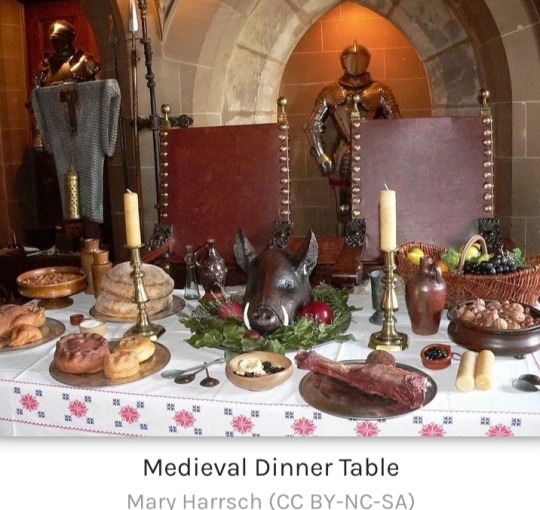
Amongst the landed aristocracy, comfortable in their castles and manors, Christmas gifts such as fine clothes and jewellery to wear for the season were exchanged on the 25th of December.
There was another round of gift-giving on the 1st of January, too. Known as 'first-gifts,' they were thought to be an omen of a person's fortune in the coming year.
Much like today, though, the real joy of Christmas for many was the food on offer.
Usually held in the Great Hall of a castle or manor, the setting for the Christmas meal for the aristocracy was suitably splendid with high wood-beam ceilings and at least one roaring fire.
The hall was made even more impressive with festive garlands of holly, ivy and other seasonal greenery.
The tables were set with the usual knives, spoons and a thick slab of one-day-old bread (a trencher or manchet) to be used by way of a plate for meat.
Christmas diners were also treated to the luxury of a change of tablecloth after each course.
Two diners shared a bowl for washing hands (everything except liquids was eaten with the fingers), another bowl for soups and stews, and a small bowl of salt.
Served as an early lunch, the first course was typically a soup, broth or weak stew with some meat at the bottom.
The second course might be a vegetable stew (porray) of leeks and onions.
The rich were fortunate enough to have meat as their next course on ordinary days – rabbit, hare and chicken, for example – but Christmas saw finer meat delicacies, fish (e.g. salmon, herring and trout) and seafood (e.g. eels, oysters and crab) courses presented to the guests.
Meats were roasted on a spit over an open fire. Besides legs of beef and mutton, there was veal, venison, goose, capon, suckling pig, duck, plover, lark and crane, to name a few.
A special Christmas dish the cooks might prepare to wow the guests included a boar's head on a platter or a swan or peacock roasted in its feathers.
Sauces added more flavour to many dishes and, thickened with breadcrumbs, they contained wine or vinegar, and herbs and spices.
Dessert consisted of thick fruit custards, pastries, nuts, cheese and luxury fruits like oranges, figs and dates.
There were also entremets – various decorated nibbles glazed with sugar and honey – which were served before the dessert course at Christmas and other feasts.
For drinks, there's red and white wine (from a cup shared with one's dining partner), which was drunk young as it had a short shelf-life.
Wine was often mixed with water or sweetened with honey or sugar.
Alternatives were cider and ale, although the latter, made from grains and fermented with yeast, was considered a lower class drink.
Beer made using hops would only appear in the late Middle Ages. Dessert might be accompanied by a jug of spiced wine.
While all this feasting was going in the Great Hall, the servants of a castle were not forgotten as traditionally they were given better food at Christmas such as geese and hens.
Finally, the leftovers of the feast were taken outside to the waiting poor.
The manor dining table might have had some surprising guests as serfs on the castle's estate did get to live it up a little at Christmas when, by tradition, they were invited to the manor on Christmas day for a meal.
On some estates, the invitations were restricted to just two lucky recipients.
Traditionally, one of the poorest and one of the wealthiest peasants who could also invite two friends along.
Unfortunately, most peasants invited to their local lord's abode had to bring along their own plates and firewood, and of course, all the food had been produced by themselves anyway.
However, they did get free ale and it was at least a chance to see how the other half lived and relieve the dreariness of a country winter.
A Peasant Christmas
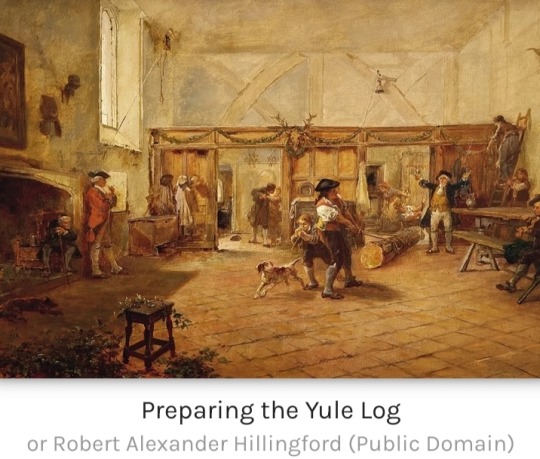
A peasant's Christmas was obviously rather less grand than that enjoyed in the local manor or castle, and for them, the season did not start well.
Serfs, already subjected to all manner of odd fees over the year, were expected to give a 'gift' to their lord at Christmas of extra bread, eggs, and perhaps, even a valuable rooster or a couple of hens.
In contrast, free labourers on the estate, especially the more important ones such as the estate's shepherd, swineherd and oxherd, received presents from the lord, typically a bonus of food, drink, clothes and firewood.
It is a tradition, which continued into later centuries, when household servants received a box of gifts on the 26th of December, hence the name of that day in Britain: Boxing Day.
Children's gifts from their humble parents included such simple toys as spinning tops, whistles, stilts, marbles, dolls, and figures made from wood or clay.
Peasants would have decorated their homes much as aristocrats did, with greenery such as holly being readily available for those who searched for it.
An old, possibly pagan tradition persisted, which was the burning of a Yule log.
Actually, a sizeable piece of tree trunk, the log was lit on Christmas Eve in homes of all kind and kept burning for the twelve days of Christmas.
For the special meals of the holiday, peasants ate that rare delicacy of – usually boiled – meat, treated themselves to cheese and eggs, ate cakes and drank ale.
There was certainly lots — the brew typically made by peasant women.
The 1st of January was important as people hoped for better fortune in the coming year.
A superstition developed, like the gifts the rich exchanged on this day, that it was terribly important who the first person to visit one's home was on New Year's Day.
Called 'first-footing,' certain characteristics were considered desirable in this first visitor: a male with a dark complexion, perhaps fair-haired and, best of all, with flat feet.
Christmas Entertainment

There were all kinds of entertainments on offer over the Christmas period.
Drinking alcohol was the most popular of all. The fact that merry-making could easily get out of hand is attested by the common custom of lords paying special watchmen to guard their estates in case of riots.
A record from an estate near Saint Paul's Cathedral in London tells us that watchmen were set from Christmas Day to Twelfth Night.
These men were recompensed by 'a good fire in the hall, one white loaf, one cooked dish, and a gallon of ale [per day]' (quoted in Gies, 208).
Even if drinking such large quantities was relatively common and the ale weak, with four and a half litres of ale per watchman, it is a wonder they themselves did not get a bit rowdy.
More genteel festive entertainment included monks touring and performing plays in private residences, which told key episodes from the Bible, especially, of course, seasonal topics such as the Massacre of the Innocents by Herod.
Similarly, in cities, medieval guilds put on public pageants where wagons went through the streets carrying people dressed as personalities from the Bible's Christmas story.
Troupes of masked pantomime artists known as mummers went through the streets, too, accompanied by bands of musicians.
Sometimes numbering over 100 revellers, they dressed in outlandish costumes as lords, cardinals and knights, and even ventured into people's homes to dance and play dice.
Receiving food and drink in return for their entertainment, mummers often performed short plays with scenes from familiar legends such as Saint George and the dragon.
There were games like cards and dice (which included a bit of gambling) and board games such as chess, checkers, backgammon and Nine Men's Morris.
Traditional Christmas games included the 'king of the bean,' which permitted the person who found a hidden bean in the bread or a special cake to be 'king' or 'queen' of the feast.
That honoured person then had the right to lord it over everyone else who often had to mimic whatever action the king or queen did at the table.
The game was traditionally played on Twelfth Night and was an example of the tried-and-tested role-reversal hilarity, which went back to Rome's pagan December festival of Saturnalia.
Christmas meals were followed by more drinking of wine or beer, singing of songs, including carols, and group dancing to music from pipes, flutes, lutes and drums.
Professional acrobats and jongleurs (minstrels) performed their tricks and witty verses.
Folktales were told, embellished and re-told every year, puppet shows were put on, and people played parlour games, many of which survive today such as blind man's buff and prisoner's base.
Another such game involved one member of the party being dressed as a saint while everyone else had to make them an offering (no doubt, an amusing one), which they had to do without smiling and resisting the antics of the saint or else they themselves became the saint.
Another game was 'The King Who Does Not Lie' when the 'king of the feast' might ask a question to any guest who, if they answered truthfully, could ask a question in return.
Such games were, of course, a chance to show one's wit and skill at wordplay, to embarrass a friend or to find out a sweetheart's inclinations.
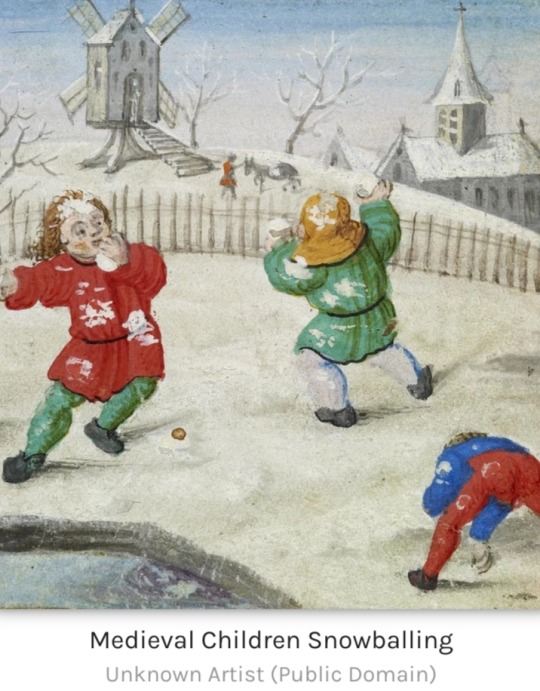
For the more energetic, there were sports such as feats of strength, archery, wrestling, bowling, hockey, and medieval football where the goal was to move the ball to a predetermined destination and there were few, if any, rules.
Sliding on frozen lakes was a popular activity in winter, too.
Alternatively, by strapping the shin bones of a horse to the feet and grabbing a pole for propulsion, the courageous could try ice skating.
The End of the Holiday
Christmas through the ages has witnessed festive fun and frolics, and so, inevitably, the return to ordinary working life must have been something of a shock in the medieval period after this longest of holidays.
However, even then peasants made a celebratory game of the proceedings by, for example, holding a plough race at sunrise on the first Monday after Epiphany, known as Plough Monday.
There was another tradition, perhaps again to lighten the burden of returning to the daily toil, on 7th January, also known as Saint Distaff's Day.
This day was “a day of carnival, an occasion for 'misrule,' for 'comic battles between the sexes' in which men set fire to women's flax and women made sure men got soaked” (Leyser, 225).
#Medieval Christmas#Christmas#holly#mistletoe#Christmas Tree#medieval times#troping#Feast of the Holy Innocents#Childermas#Feast of the Circumcision#Feast of Fools#first-footing#Boxing Day#Twelfth Night#Plough Monday#Saint Distaff's Day
11 notes
·
View notes